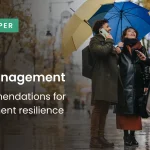Mergers and acquisitions (M&A) are expected to rebound in 2024, returning from 2023’s sparse deal activity.1 While M&A is typically associated with corporate and finance strategies, the procurement function is crucial in ensuring M&A success. From a procurement perspective, M&A often presents opportunities for companies to enhance their purchasing power, expand into new markets, and streamline operations, which can increase competitiveness and profitability.
 $2 trillion per year
$2 trillion per year
Of the $2 trillion spent each year on acquisitions, it’s estimated that 70-90% fails to deliver the anticipated results.2
 Conducting due diligence
Conducting due diligence
Procurement teams are often asked to conduct due diligence to evaluate potential savings and supply chain benefits associated with a potential merger or acquisition.
During this discovery phase, the target company’s spend, supplier contracts, relationships, purchasing processes, and supply chain synergies and challenges should be reviewed.
- Evaluate supplier relationships across each organization to identify areas for consolidation.
- Determine the importance of each supplier, align with a single provider for comparable products or services, eliminate duplications, and negotiate favorable terms to establish preferred suppliers.
- Assess and work to mitigate procurement-related risks arising from the deal, such as supplier disruptions, contractual issues, or regulatory compliance.
Engaging a third-party service provider can greatly enhance the due diligence process. Their expertise ensures a detailed review of the expected savings and benefits of the M&A. This helps assess synergies, identify integration hurdles, and evaluate the deal and merged organization’s value.
 Staffing up
Staffing up
Mergers often adhere to tight timelines, placing pressure on the procurement team to produce rapid results. This can stretch resources and restrict their ability to manage the intricacies of combining procurement functions. When your company transitions to acquisition mode, consider augmenting your existing team to maintain consistent support for internal stakeholders and ensure smooth operations.
 Supporting successful integrations
Supporting successful integrations
Procurement is key in addressing integration challenges early and maximizing value. By finding common goals and crafting a unified strategy, it ensures the procurement process supports the new organization’s objectives. At this stage, the focus is on simplifying procurement systems, making processes uniform, staying compliant with regulations, and using the best practices from both organizations to boost efficiency.
Top Recommendations

Strategic Contract Separation Plan
Review all existing contracts, terms, and conditions from both companies to understand obligations, commitments, and potential risks.

Contractual Review and Analysis
Develop a plan to manage the separation of contracts when only one of a company’s business units is being acquired.

Restructuring for Alignment
Renegotiate contracts where necessary to align with the new organizational structure and requirements.
Strategic Contract Separation Plan
Review all existing contracts, terms, and conditions from both
companies to understand obligations, commitments, and potential risks.
Restructuring
for Alignment
Renegotiate contracts
where necessary to align
with the new organizational
structure and requirements.
Top
Recommendations



Contractual Review
and Analysis
Develop a plan to manage
the separation of contracts
when only one of a company’s
business units is being acquired.
 Revisiting technology infrastructure
Revisiting technology infrastructure
Integrations often require significant changes to IT systems, presenting an ideal opportunity to assess the digital tools used in procurement and lay the foundation for long-term digital planning. Consolidating procurement functions fosters innovation and collaboration and enhances supplier relationship management and market responsiveness.
It is crucial to evaluate the technology landscape and determine the most effective approach for consolidating tools and applications. Standardizing processes, implementing consistent tools, and leveraging analytics can drive efficiencies and generate data-driven insights to inform sourcing decisions. Additionally, streamlining technology reduces support needs and offers potential future cost savings.
 Positioning change as opportunity
Positioning change as opportunity
Stakeholders affected by an M&A deal can be especially vulnerable to leaving the organization. As such, it is important to proactively manage change with a detailed approach, clear communication, and training. Encourage a sense of ownership and collaboration to support a smooth transition.
Procurement is key in addressing integration challenges early and maximizing value. By finding common goals and crafting a unified strategy, it ensures the procurement process supports the new organization’s objectives. At this stage, the focus is on simplifying procurement systems, making processes uniform, staying compliant with regulations, and using the best practices from both organizations to boost efficiency.
Author:
Contributors:
, Chief Marketing Officer, Arroyo Strategy


